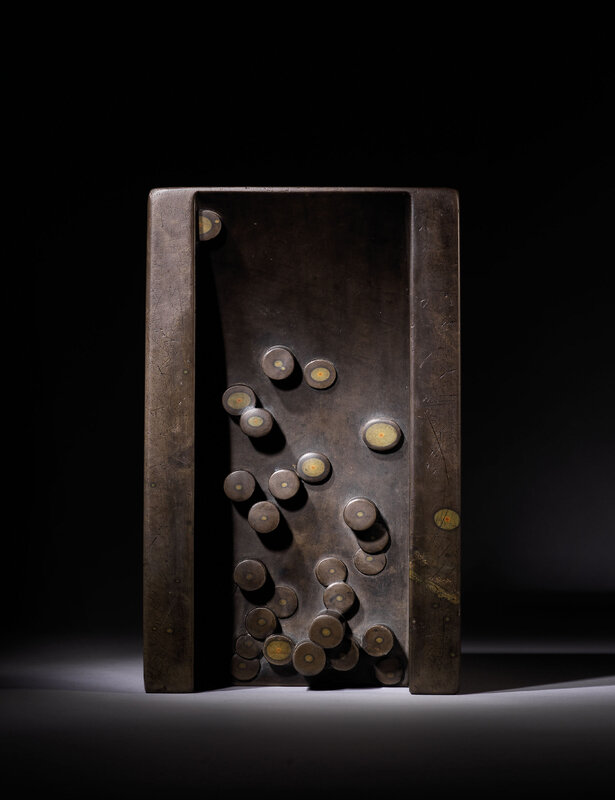Christie's. Beyond Compare: A Thousand Years of the Literati Aesthetic (Evening Sale), Hong Kong, 26 November 2018
An extremely rare Duan ink stone, Song-Ming dynasty (960-1644)



Lot 8016. An extremely rare Duan ink stone, Song-Ming dynasty (960-1644); 9 1/2 in. (24.1 cm.) wide. Estimate HKD 400,000 - HKD 600,000. Price realised HKD 1,750,000. © Christie's Images Ltd 2018.
The upper surface is smoothly polished with a narrow, shaped indentation on one end forming the inkwell beneath an olive-green ‘eye’. The hollowed sloping underside is scattered with twenty-eight cylinders of varying heights representing the Twenty-Eight Mansions of the Chinese constellation system, below another ‘eye’ at the corner symbolising the moon, each of these cylinders is centred with an ‘eye’. The stone is of a deep purplish-brown colour with olive-green mottling and dark brown veining.
Provenance: Date Family, acquired in 19th century (by repute)
Nagao Uzan (1864-1942), Kyoto
Matsunaga Shuji (1884-1972), Tokushima Prefecture
Shimoda Kozan (dates unknown), acquired in 1938
Matsubayashi Gadai (dates unknown), acquired before 1943
A Japanese private collection, acquired in the late 1980s.
Literature: Shoen, vol. 3: no. 1, Tokyo, 1939, p. 47 (fig. 1)
Meikenten, Tokyo, 1987, no. 13.
Exhibited: Mayuyama Ryusendo, Meikenten, 9-15 October 1987, no. 13.
Note: Duan stones are the most admired materials for grinding ink, and had been mined from Zhaoqing, Guangzhou as early as the Tang dynasty. The stones are known for their smoothness, which allows for easier grinding without damaging the brushes. Duan stones contain several kinds of veining and patterns, one of the most desirable attributes is the ‘eye’, which is a natural inclusion that exists in the form of concentric circles. The value of an inkstone depends on the number and quality of the ‘eyes’. Its desirability is determined by the quantity of ‘eyes’ present, their roundness, size, and colour intensity of the concentric circles. An ‘eye’ that resembles a crested myna is the rarest and receives the highest praise, such as the ones found on the present inkstone.
One of the most famous and widely recorded Duan inkstones is from the Qing Court collection, and now in the National Palace Museum, Taipei. Of no more than 15 cm. long, the inkstone has more than sixty ‘eyes’, with an incised inscription signed Su Shi, and a further inscription by the Qianlong Emperor. Of comparable quality is another Duan inkstone in the Palace Museum, Beijing, which is very similar in size (27 cm. long) and form to the present inkstone. The quality of ‘eyes’ is comparable among these three inkstones, with the present inkstone having the fewest in number, but some of largest and most distinctive. The carver of the present inkstone had ingeniously utilised the ‘eyes’ in the stone and worked them into cylinders of different heights to represent the Twenty-Eight Mansions of the Chinese Constellation System, across from a single ‘eye’ at one corner symbolising the moon, echoing the scene projected by one of Cao Zhi’s (AD 192-232) poems: ‘shadow under the clear moon, constellations across the sky’.
The underside of the accompanying box cover bears a calligraphic inscription signed by an unrecorded scholar Shimoda Kozan in 1938, in which he praised the quality of the inkstone and provided the names of two previous owners, the sinologist Nagao Uzan (1864-1942), and poet Matsunaga Shuji (1884-1972). On the inside cover within the box are three additional inscriptions signed by the renowned sinologist Ono Shozan (1880-1952), who is known for his extensive research on the Four Treasures of a Scholar’s Studio, brushes, ink cakes, papers, and inkstones. In one of the inscriptions dated 1943, he mentiond that the inkstone was sold by Shimoda Kozan to Matsubayashi Gadai, when the former needed money on an occasion when Matsubayashi Gadai was visiting Ono Shozan.

/https%3A%2F%2Fprofilepics.canalblog.com%2Fprofilepics%2F1%2F0%2F100183.jpg)
/https%3A%2F%2Fstorage.canalblog.com%2F03%2F02%2F119589%2F96711876_o.jpg)
/https%3A%2F%2Fstorage.canalblog.com%2F11%2F31%2F119589%2F94773502_o.jpg)
/https%3A%2F%2Fstorage.canalblog.com%2F20%2F83%2F119589%2F94772815_o.jpg)
/https%3A%2F%2Fstorage.canalblog.com%2F26%2F72%2F119589%2F75604929_o.jpg)
/https%3A%2F%2Fstorage.canalblog.com%2F59%2F60%2F119589%2F26458628_o.jpg)


/http%3A%2F%2Fstorage.canalblog.com%2F01%2F21%2F119589%2F127242111_o.jpg)
/http%3A%2F%2Fstorage.canalblog.com%2F29%2F40%2F119589%2F126803700_o.jpg)
/http%3A%2F%2Fstorage.canalblog.com%2F22%2F02%2F119589%2F126758476_o.jpg)
/http%3A%2F%2Fstorage.canalblog.com%2F23%2F39%2F119589%2F111178789_o.jpg)